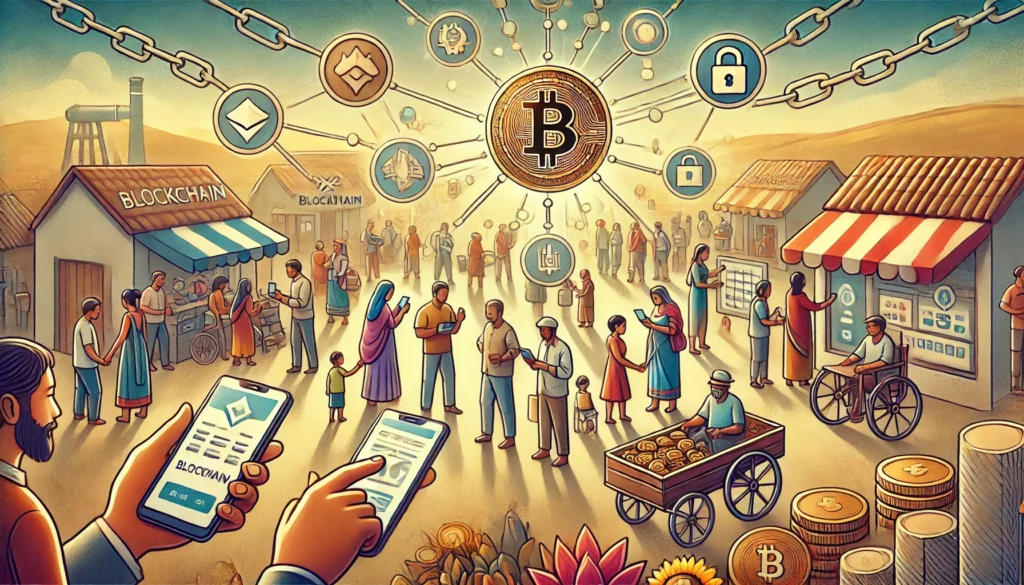In today’s interconnected world, access to financial services is essential for economic empowerment. However, despite the rapid growth of global financial systems, over 1.7 billion people remain unbanked, meaning they lack access to basic financial services like savings accounts, credit, insurance, and the ability to make payments. These individuals, often living in remote or underserved regions, face significant challenges that prevent them from participating in the formal economy. Issues like high transaction costs, limited access to banking infrastructure, lack of identification, and exclusion from credit systems prevent them from building wealth and improving their living conditions.
Blockchain technology, known for its decentralized and secure nature, is increasingly recognized as a powerful tool for promoting financial inclusion. By providing a transparent, efficient, and affordable alternative to traditional banking, blockchain opens up access to financial services for the unbanked, empowering them to save, invest, and access credit. This article explores how blockchain is revolutionizing financial inclusion and its potential to transform the lives of millions around the world.
The Barriers to Financial Inclusion
For many unbanked individuals, the inability to access financial services is not a matter of personal choice but a result of systemic barriers. Traditional banking institutions often overlook low-income and rural populations, where the cost of providing banking services is high. Many banks have strict requirements, such as minimum account balances, that make it difficult for people with low incomes to participate in the formal financial system.
Additionally, in many developing countries, people lack government-issued identification, making it nearly impossible to open a bank account or engage in financial transactions. Even when financial institutions are available, the cost of using their services—such as high fees for basic transactions, remittances, or loans—can prevent low-income individuals from utilizing them.
For the unbanked, this exclusion can lead to a range of issues, from the inability to save money or access credit, to being left out of the global economy and unable to take part in opportunities for social and economic advancement.
Blockchain: A Solution for Financial Inclusion
Blockchain technology, originally designed to underpin cryptocurrencies like Bitcoin, offers a range of features that make it ideal for solving many of the issues that contribute to financial exclusion. At its core, blockchain is a distributed ledger system that operates without a central authority. Transactions are recorded on a transparent, immutable ledger, and once data is entered, it cannot be altered. This ensures the security, integrity, and trustworthiness of information shared across the network.
For individuals who have no access to traditional banking services, blockchain offers an accessible, low-cost, and highly secure way to engage with financial services. By removing intermediaries and providing decentralized verification of transactions, blockchain can provide a financial ecosystem where unbanked populations can store, transfer, and access money, credit, and savings securely and affordably.
How Blockchain Empowers the Unbanked
Blockchain addresses several key issues that unbanked populations face, enabling access to financial services in the following ways:
1. Decentralized and Borderless Financial Services
Blockchain’s decentralized nature means that individuals do not need a central authority—like a bank or payment service provider—to engage in financial transactions. All that is required is an internet connection, making blockchain an ideal solution for people in regions where banks are inaccessible or costly. Cryptocurrencies, which are built on blockchain technology, can be used for transferring money, making payments, and storing value. These services can be accessed using mobile phones, which are far more widely available in developing regions than traditional banking infrastructure.
For instance, cryptocurrencies like Bitcoin and Stellar enable cross-border payments and remittances, allowing individuals to send money across borders without the need for expensive intermediaries. Traditional remittance services often charge high fees for sending money internationally, which makes it difficult for low-income individuals to send funds to their families or business partners. Blockchain reduces these fees significantly, providing a more affordable way for individuals to engage in the global economy.
2. Financial Services Without Intermediaries
One of the most significant advantages of blockchain is its ability to facilitate financial transactions without the need for intermediaries. Traditional financial systems rely on banks, credit agencies, and other financial institutions to verify transactions, manage accounts, and provide loans. These intermediaries add layers of complexity, cost, and inefficiency to financial services, often excluding low-income populations who cannot afford these services.
With blockchain, individuals can bypass these intermediaries, and transactions can occur directly between parties. This reduces the overall cost of transactions and makes financial services more accessible to people who were previously excluded from the banking system. Blockchain-based systems also enable peer-to-peer lending, where individuals can access microloans without relying on traditional credit checks or loan approval processes.
3. Creating and Managing Digital Identities
A significant barrier to financial inclusion for the unbanked is the lack of formal identification. Many individuals living in rural areas or in developing countries do not have the documentation required to open a bank account or access financial services. Blockchain can provide a solution through self-sovereign identity systems that enable individuals to create and manage their own digital identities.
Self-sovereign identities are decentralized and stored securely on the blockchain, giving individuals control over their personal data. These identities can be used to access financial services without needing government-issued IDs or other documentation. In addition, blockchain’s transparent and immutable nature ensures that the information associated with the digital identity is secure and verifiable.
4. Access to Credit and Loans
Lack of access to credit is another major challenge for the unbanked. Traditional banks typically require a formal credit history before offering loans or credit lines, which many unbanked individuals do not have. Blockchain’s ability to create verifiable transaction histories through decentralized ledgers can help address this issue by enabling individuals to build a financial reputation through their blockchain activity.
Platforms are already emerging that use blockchain to offer microloans or peer-to-peer lending services to individuals with little to no credit history. These loans are backed by smart contracts, which automatically execute when conditions are met, reducing risk for lenders and ensuring trust in the system. This makes credit accessible to people who have traditionally been excluded from formal lending systems.
Real-World Applications and Impact
1. Cryptocurrency and Mobile Banking
In countries like Kenya, mobile banking has become the cornerstone of financial inclusion, with services like M-Pesa enabling millions of people to send money, pay bills, and access financial services through their mobile phones. Blockchain can take this to the next level by providing even more affordable, transparent, and secure financial tools.
2. Microfinance and Blockchain Lending
Organizations like Kiva are already exploring blockchain-based microloans, allowing individuals in developing countries to borrow small amounts of money for business ventures. These blockchain solutions can increase the efficiency of microfinance operations and ensure that funds are distributed transparently and directly to borrowers.
Challenges and the Road Ahead
While blockchain presents immense potential for financial inclusion, challenges remain. Scalability of blockchain networks to handle a large volume of transactions, especially in regions with low internet access, is one concern. Moreover, digital literacy and the ability to access smartphones or computers are still barriers for some populations. Regulatory frameworks also need to be developed to ensure that blockchain-based financial systems comply with local laws and regulations.
However, as technology continues to evolve, blockchain offers the potential to overcome these obstacles and bring financial services to billions of unbanked individuals around the world.
Blockchain in Financial Inclusion
Blockchain technology has the potential to revolutionize financial inclusion by providing decentralized, affordable, and accessible financial services to the unbanked. Through blockchain, individuals can access essential financial tools such as payments, credit, and savings without the need for traditional banking infrastructure. By addressing key barriers such as cost, lack of access to infrastructure, and identity verification, blockchain is helping to create a more inclusive global financial system.
As the adoption of blockchain grows and its integration into financial systems becomes more widespread, the unbanked populations around the world stand to gain unprecedented access to financial services, ultimately driving economic empowerment and reducing inequality on a global scale.


